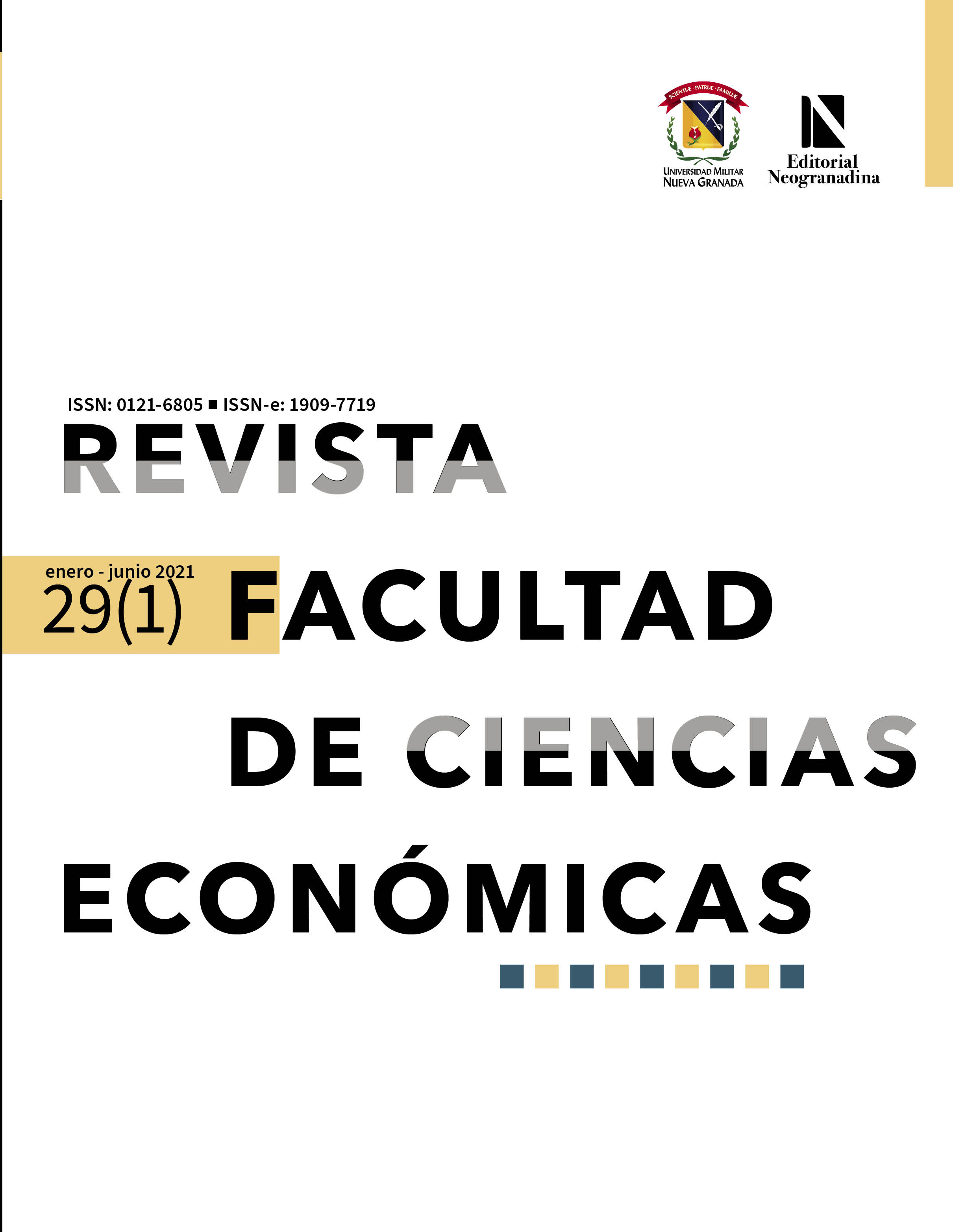Financial Difficulty and Market Performance in Latin American Organizations
Abstract
Financial difficulty is examined in various literature studies. However, its determining factors, such as the indicator, are further discussed without considering its impact on the market. The purpose of this work is to identify the impacts of financial difficulty on the market performance of listed Latin American companies, since it is an es- sential tool to determine the continuity of an organization. The efficient market and signaling hypothesis states that financial difficulty heralds a negative outlook for the market that impacts market performance. Thus, the analysis used data about companies listed on the Argentina, Brazil, Chile, Mexico, and Peru stock exchanges on a quarterly basis from 2013 to 2017. The results show that financial difficulty negatively impacts company market performance in the Brazilian, Chilean, and Mexican contexts. The study contributes to the literature with the use of financial difficulty in addition to a predictive indicator, as it shows information that can be used by stakeholders at the time of negotia- tion or maintenance of their stock portfolio.
Downloads
References
Al-Hadi, A., Chatterjee, B., Yaftian, A., Taylor, G. e Mon- zur Hasan, M. (2017). Corporate social responsibility performance, financial distress and firm life cycle: Evidence from Australia. Accounting & Finance, 59(2), 961-989. https://doi.org/10.1111/acfi.12277
Altman, E. I. (1968). Financial ratios, discriminant analy- sis and the prediction of corporate bankrupty. The Journal of Finance, XXIII(4), 589-609.
Altman, E. I. e Hotchkiss, E. (2010). Corporate financial distress and bankruptcy: Predict and avoid bankrupt- cy, analyze and invest in distressed debt. Nova Jersey: John Wiley & Sons.
Andrade, G. e Kaplan, S. N. (1998). How costly is fi- nancial (not economic) distress? Evidence from highly leveraged transactions that became Dis- tressed. The Journal of Finance 53(5), 1443-1493. https://doi.org/10.1111/0022-1082.00062
Asquith, P., Gertner, R. e Scharfstein, D. (1994). Anatomy of Financial Distress an examination of junk-bond is- suers. Quarterly Journal of Economics, 109(3), 625-658.
Bae, J. K. (2012). Predicting financial distress of the South Korean manufacturing industries. Expert Systems with Applications, 39(10), 9159-9165. https://doi.org/10.1016/j.eswa.2012.02.058
Balcaen, S. e Ooghe, H. (2006). 35 years of studies on business failure: An overview of the classic statistical methodologies and their related pro- blems. British Accounting Review, 38(1), 63-93. https://doi.org/10.1016/j.bar.2005.09.001
Bastos, D. D., Nakamura, W. T. e Basso, L. F. C. (2009). Determinantes da estrutura de capital das companhias abertas na América Latina: um estudo empírico con- siderando fatores macroeconômicos e institucionais. Ram — Revista de Administração Mackenzie, 9(6), 47- 77. https://doi.org/10.1590/S1678-69712009000600005
Batten, J. A., Gannon, G. L. e Thuraisamy, K. S. (2017). Sovereign risk and the impact of crisis: Evidence from Latin America. Journal of Banking & Finance, 77, 328- 350. https://doi.org/10.1016/j.jbankfin.2016.07.011
Beaver, W. H. (1966). Financial Ratios as Predictors of Failure. Journal of Accounting Research, 4, 71-111.
Brenes, E. R., Camacho, A. R., Ciravegna, L. e Pichardo, C. A. (2016). Strategy and innovation in emerging econo- mies after the end of the commodity boom — Insights from Latin America. Journal of Business Research, 69, 4363-4367. https://doi.org/10.1016/j.jbusres.2016.03.059
Bunn, P. e Redwood, V. (2003). Company accounts based modelling of business failures and the implications for financial stability. Bank of England. https://doi.org/10.2139/ssrn.598276
Chang, H. H. e Wong, K. H. (2010). Adoption of e-procurement and participation of e-marketpla- ce on firm performance: Trust as a moderator. Information and Management, 47(5-6), 262-270. https://doi.org/10.1016/j.im.2010.05.002
Chatziantoniou, I., Duffy, D. e Filis, G. (2013). Stock market response to monetary and fiscal policy shocks: Mul- ti-country evidence. Economic Modelling, 30(1), 754- 769. https://doi.org/10.1016/j.econmod.2012.10.005
Cuervo-Cazurra, A. (2008). The multinationalization of developing country MNEs: The case of multilatinas. Journal of International Management, 14, 138-154. https://doi.org/10.1016/j.intman.2007.09.001
Errunza, V. (2001). Foreign portfolio equity investments, financial liberalization, and economic development. Review of International Economics, 9(4), 703-726. https://doi.org/10.1111/1467-9396.00308
Fallahpour, S., Lakvan, E. N. e Zadeh, M. H. (2017). Using an ensemble classifier based on sequential floating fo- rward selection for financial distress prediction pro- blem. Journal of Retailing and Consumer Services, 34, 159-167. https://doi.org/10.1016/j.jretconser.2016.10.002
Fama, E. F. (1970). Efficient Capital Markets: A Review of The- ory and Empirical Work. Journal of Finance, 25(2), 383- 417. https://doi.org/10.1111/j.1540-6261.1970.tb00518.x
Fávero, L. P., Belfiore, P., Da Silva, F. L. e Chan, B. L. (2009).
Análise de dados: modelagem multivariada para toma- da de decisões. São Paulo: Campus.
Figini, S., Maggi, M. e Uberti, P. (2018). The market rank in- dicator to detect financial distress. Econometrics and Sta- tistics, 0, 1-11. https://doi.org/10.1016/j.ecosta.2017.12.001
Figlioli, B., Lemes, S. e Lima, F. G. (2017). ifrs, synchro- nicity, and financial crisis: The dynamics of accounting information for the Brazilian capital market. Revista Contabilidade & Finanças, 28(75), 326-343. https://doi.org/10.1590/1808-057x201704450
fmi. (2018). Fundo Monetário Internacional. Recuperado de https://www.imf.org/external/index.htm
Geng, R., Bose, I. e Chen, X. (2015). Prediction of financial distress: An empirical study of listed Chinese companies using data mining. European Journal of Operational Research, 241(1), 236-247. https://doi.org/10.1016/j.ejor.2014.08.016
Groppelli, A. A. e Nikbakht, E. (2006). Administração fi- nanceira (2a ed.). São Paulo: Saraiva.
Hillegeist, S. A., Keating, E. K., Cram, D. P. e Lunds- tedt, K. G. (2004). Assessing the probability of bankruptcy. Review of Accounting Studies, 9(1), 5-34. https://doi.org/10.1023/B:RAST.0000013627.90884.b7
Inekwe, J. N., Jin, Y. e Valenzuela, M. R. (2018). The effects of financial distress: Evidence from us gdp growth. Economic Modelling, 72, 1-14. https://doi.org/10.1016/j.econmod.2018.01.001
Keasey, K. e Mcguinness, P. (1990). The Failure of Uk industrial firms for the period 1976-1984, logistic analysis and entropy measures. Journal of Business Finance & Accounting, 17(1), 119-135. https://doi.org/10.1111/j.1468-5957.1990.tb00553.x
Laitinen, E. K. e Suvas, A. (2016). Financial distress pre- diction in an international context: Moderating effects of Hofstede’s original cultural dimensions. Journal of Behavioral and Experimental Finance, 9, 98-118. https://doi.org/10.1016/j.jbef.2015.11.003
Lian, Y. (2017). Financial distress and customer-supplier relationships. Journal of Corporate Finance, 43, 397- 406. https://doi.org/10.1016/j.jcorpfin.2017.02.006
Medrado, F., Cella, G., Pereira, J. V. e Dantas, J. A. (2016). Relação entre o nível de intangibilidade dos ativos e o valor de mercado das empresas. Re- vista de Contabilidade e Organizações, 28, 33-44. https://doi.org/10.11606/rco.v10i28.119480
Mensi, W., Hammoudeh, S., Reboredo, J. C. e Nguyen, D. K. (2014). Do global factors impact brics stock markets? A quantile regression approach. Emerging Markets Review, 19, 1-17. https://doi.org/10.1016/j.ememar.2014.04.002
Mselmi, N., Lahiani, A. e Hamza, T. (2017). Financial dis- tress prediction: The case of French small and medium- -sized firms. International Review of Financial Analysis, 50, 67-80. https://doi.org/10.1016/j.irfa.2017.02.004
Neto, J. e Martins, H. (2010). Finanças e governança corpo- rativa. Rio de Janeiro: Elsevier.
Ohlson, J. A. (1980). Financial ratios and the probabilis- tic prediction of bankruptcy. Journal of Accounting Research, 18(1), 109. https://doi.org/10.2307/2490395
Pindado, J., Rodrigues, L. e de la Torre, C. (2008). Estimating financial distress likelihood. Jour- nal of Business Research, 61(9), 995-1003. https://doi.org/10.1016/j.jbusres.2007.10.006
Póvoa, A. C. S. e Nakamura, W. T. (2014). Homo- geneidade versus heterogeneidade da estrutura de dívida: um estudo com dados em painel. Re- vista Contabilidade & Finanças, 25(64), 19-32. https://doi.org/10.1590/s1519-70772014000100003
Ress, W. P. (1995). Financial analysis. Londres: Prentice- -Hall.
Ross, S. A., Westerfield, R. W. e Jaffe, J. (2002). Administra- ção financeira: corporate finance, Tradução de Antônio Zoratto Sanvicente (2. ed.). São Paulo: Atlas.
Soliman, M. T. (2004). Using Industry-Adjusted Du- pont Analysis to Predict Future Profitability. Ssrn. https://doi.org/10.2139/ssrn.456700
Sun, J. e Li, H. (2012). Financial distress prediction using support vector machines: Ensemble vs. individual. Applied Soft Computing Journal, 12(8), 2254-2265. https://doi.org/10.1016/j.asoc.2012.03.028
Tinoco, M. H. e Wilson, N. (2013). Financial distress and bankruptcy prediction among listed companies using accounting, market and macroeconomic variables.International Review of Financial Analysis, 30, 394- 419. https://doi.org/10.1016/j.irfa.2013.02.013
Vuchelen, J. (2003). Electoral systems and the effects of political events on the stock market: The Bel- gian case. Economics and Politics, 15(1), 85-102. https://doi.org/10.1111/1468-0343.00116
Wanke, P., Barros, C. P. e Faria, J. R. (2015). Financial distress drivers in Brazilian banks: A dynamic slacks approach. European Journal of Operational Research, 240(1), 258- 268. https://doi.org/10.1016/j.ejor.2014.06.044
Wernke,R.eLembeck,M.(2004).Análisederentabilidadedos segmentos de mercado de empresa distribuidora de mer- cadorias. Revista Contabilidade & Finanças, 15(35), 68- 83. https://doi.org/10.1590/S1519-70772004000200006
Whitaker, R. B. (1999). The early stages of financial dis- tress. Journal of Economics and Finance, 23(2), 123- 132. https://doi.org/10.1007/BF02745946
Wilcox, J. W. (1971). A Simple theory of financial ratios as predictors of failure. Journal of Accounting Research9(2) 389-395. https://doi.org/10.1080/03056249708704247












